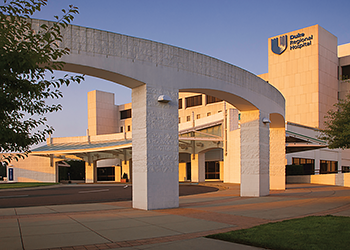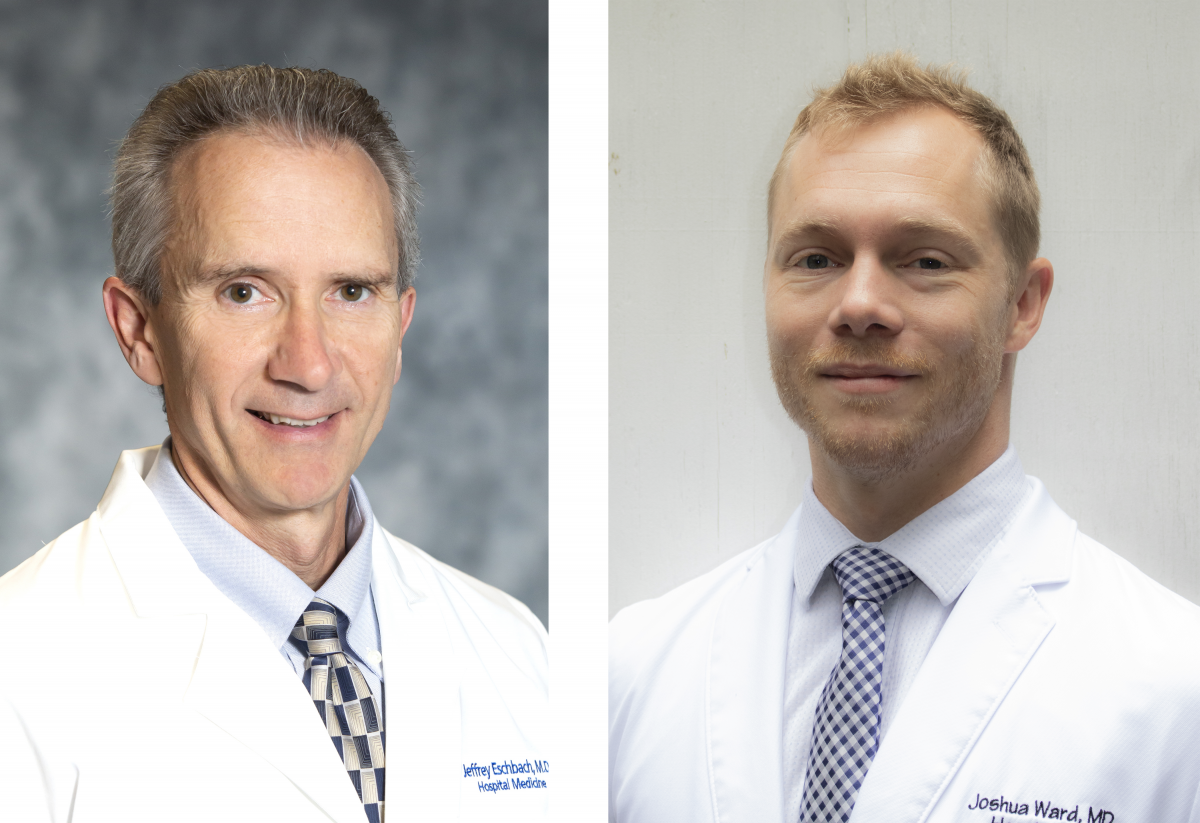
For the first time in about 20 years, Duke family medicine residents have an inpatient presence at a Duke Health hospital.
A new family medicine inpatient service began at Duke Regional Hospital on July 1, 2020, and represents a sort of homecoming for the Duke Family Medicine Residency Program. The program’s first hospital presence in the 1970s was at Watts Hospital (when the residency was a joint venture between Duke and Watts), then Durham County General Hospital (later renamed Durham Regional Hospital, then Duke Regional Hospital). In 1991, the service moved to Duke University Hospital, then shut down completely in the early 2000s. Since then, residents have traveled to UNC Hospitals to complete required inpatient medicine rotations.
— Read more about the history of family medicine at Duke —
“There’s been a recognition for some time now that there would be great value in having our own family medicine inpatient service again, and we just needed the right set of circumstances and partners to bring that to life,” says Will Bynum, M.D., associate professor of family medicine and community health and program director, Duke Family Medicine Residency.
Bynum, who joined the program faculty in 2017, has spent the past two years helping to lead the effort to bring an inpatient service back to Duke Regional Hospital (DRH). This effort brought together family medicine residents with leadership from DRH and the Department of Family Medicine & Community Health.
“What’s really great about this process is that it’s been so collaborative,” Bynum says. “There is a consistent and shared commitment among all stakeholders to the value that family medicine brings to the inpatient setting.”
Building a Family Medicine Hospitalist Presence
Bynum says, first and foremost, that the family medicine residents have contributed to the successful development of the inpatient service.
“They have been very flexible, adaptable, patient, diligent with their feedback, and open to change,” Bynum says. “Undergoing a significant curricular shift like this—which brings with it increased responsibilities for them—can be intimidating and anxiety-provoking, but they have handled it beautifully. They are a key reason it’s off to a really great start.”
On the DRH side, Bynum credits David Gallagher, M.D., associate professor of medicine and chief of hospital medicine programs at Duke University Health System (DUHS); Lalit Verma, M.D., associate professor of medicine and director of hospital medicine at DRH; and Poonam Sharma, M.D., SFMH, associate professor of medicine and associate medical director of hospital medicine at DRH—as well as their administrative teams—with having instrumental roles in the development of the inpatient rotation.
“They have been so accommodating and supportive of building this service,” Bynum says “Without that support, this simply would not have been possible. It has taken a new level of a commitment to the value that family medicine brings to the health system and to their hospital to make this service such a success, and we can’t express enough appreciation for their partnership. It has been a total game-changer for us.”
Within the department, Bynum says that the development of the inpatient rotation would not have been possible without the leadership of Anthony Viera, M.D., MPH, professor and chair of the Department of Family Medicine and Community Health; John Ragsdale, M.D., associate professor of family medicine and community health, chief of the Division of Family Medicine, and chair of the Department of Family Medicine at DRH; as well as new faculty members Jeffrey Eschbach, M.D., Director of the Family Medicine Inpatient Service at DRH, and Joshua Ward, M.D.

Both Eschbach and Ward joined the department last summer as adjunct faculty and family medicine hospitalists at DRH, bringing a wealth of knowledge from academic and hospital medicine. Bynum says they “have been significant catalysts” in getting the service up and running.
“From an educational and clinical care teaching experience, it really is optimal to have our residents learn in an environment where family medicine physicians are practicing. Being able to learn from their own faculty [like Eschbach and Ward] and to work with one another in particular are ideal aspects of an inpatient family medicine experience,” Bynum says.
— Learn more about Eschbach and Ward —
What is a Family Medicine Inpatient Service?
The family medicine inpatient service team consists of one intern, a second- or third-year resident, an attending physician, a PharmD and a pharmacy student. This team provides 24-7 coverage year-round, which Bynum notes is impressive for a relatively small residency program. Family medicine interns spend 2 four-week blocks on the service during their first year, and second- and third-year residents spend 1 four-week block on the service each year, with an additional four weeks each year serving as the nighttime covering resident. They work as part of an interdisciplinary team, including case managers, social workers, and occupational and physical therapists.
Eschbach says the broad depth of training that family medicine residents undergo gives them a very unique perspective to work on the inpatient service, acting as primary care providers while patients are hospitalized, overseeing and directing their care.
“Preferentially, patients that have family medicine primary care providers are admitted to the service,” Eschbach says. “In addition, patients requiring admission from the Emergency Department, those transferred from outlying hospitals, and patients that require medical consultation are cared for on the service. This allows greater continuity between the outpatient primary care providers and the hospital medicine team.”
Family medicine residents have also completed an OB rotation at DRH since July 2017, assisting in deliveries under the supervision of Tiffany Covas, M.D., MPH, assistant professor of family medicine and community health and Director of Maternal and Child Health, Duke Family Medicine Residency.
Bynum adds that DRH is the perfect hospital to give residents this type of experience, and he is excited about how this service will positively impact residents’ experiences, as well as their patients’ experiences.
“It’s community-based, and the types of medical conditions we see are aligned with the typical scope of family medicine,” Bynum says. “I think we fit in really well with the community atmosphere and culture there and are even able to contribute to that. In just the first month and a half, we’ve already heard from the residents that having this opportunity at DRH has been really rewarding so far, and we look forward to growing the service in the future to best serve our patients.”